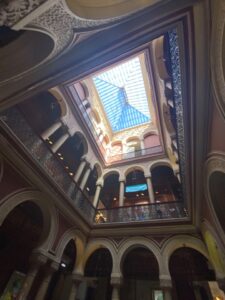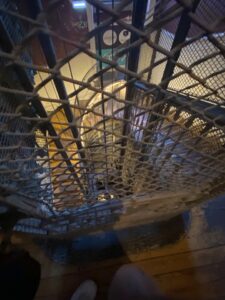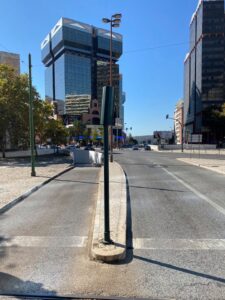Lisbon began using trolleys in the 19th Century. The ones currently in use are from the 1930s, and they’re a fun way to explore the city.

Principe Real is a beautiful neighborhood in center of the city.

The Principe Real park is at the center of the neighborhood, and includes a small “mirador,” or viewpoint over the city and the river.

We went on the weekend, when artisans showed their wares in booths along the park.

We had a delicious brunch in a glass-enclosed cafe in the park.

Wonderful food and time to talk about what we’d like to do next.

You can see the typical Pombalian architecture on these beautiful houses. This is one of the most expensive areas in Lisbon.

Another facade of tile, this one blue.

The Embaixada is a luxurious shopping gallery located within an 18th century neo-Moorish building that features extensive Art Nouveau details.

The staircase and the lighting are exquisite.

Two statues on the first floor (what we’d call the second floor) hold the lamps aloft
View from the center area, which houses a restaurant and some expensive shops.
Another view.
On the balcony in back of the building, part of the cocktail lounge.
A very old, inoperable lift.
Tile work on the floors, and throughout the building.
More scenes from our walk.
Another beautifully tiled building.
A glimpse of the river down a narrow street.
The trolley took us by this beautiful mirador, which overlooks much of the city and the river.
There were a number of theatres featuring modern shows. The Little Mermaid closed while we were there, and Vagina Monologues opened.
Camoes Square is a small plaza between the Chiado and Bairro Alto neighborhoods in the old city. The main statue is of 16th Century poet, Luis de Camões. Surrounding him on the pedestal are smaller statues of other literary figures.
This building is one of several that comprise a modern shopping, office and residential complex.
In a local food blog we found this little cafe that featured a set dinner for 5.90 Euros. Dinner included a soup of beans and greens, a Portuguese sandwich in which meat is folded into the dough and baked in a very hot oven, a cod fritter (cod is a big favorite in Lisbon), yummy rice pudding, and a drink. (I begged for the ice, and it took a while to convince her that’s what I wanted.)
The neighborhood of Castelo, home of the medieval São Jorge Castle.
The Se, the eleventh century cathedral, is very plain outside, but beautiful inside.





























0 Comments